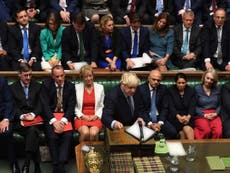What would a government of national unity actually look like? I have an idea
If Kenneth Clarke became caretaker prime minister, he would need a temporary cabinet – so who would be in it?

Kenneth Clarke could be the prime minister who asks the EU for a Brexit extension. If Boris Johnson means what he says, he is not going to reach agreement with the EU on the terms of our exit, because he insists on a customs border in Ireland, which it says is unacceptable; and, he says, there will be “no delay”.
That was what he said after he had submitted a document to the Scottish courts confirming that he would obey the law and request an extension if there is no deal. The document says: “The prime minister accepts ... that [if parliament has not approved a withdrawal agreement] ... he will send a letter in the form set out in the schedule by no later than 19 October 2019.”
The only way the two statements could be compatible is if his submission to the court were written in the third person, and the prime minister it refers to is not him – although it would appear to be a “he”.
So it could mean that whoever is prime minister on 19 October will send the letter, and that person could be Clarke. If Johnson keeps his word, he has to resign as prime minister if he cannot get a deal through parliament, and in that situation, I think Clarke would emerge as the successor “most likely to command the confidence of the House of Commons”, in the words of the Cabinet Manual.
It couldn’t be Jeremy Corbyn, as Jo Swinson rightly pointed out in an attempt to deflect attention from her own refusal to support the Labour leader. She said the 21 ex-Conservative MPs wouldn’t support him; and nor would several former – and even current – members of his own party.
If Clarke were to lead a government of national unity – even temporarily, just to send a letter and organise an election – he would need a cabinet of national unity, and ministers of national unity, and possibly parliamentary private secretaries of national unity. Even Ed Vaizey, who Johnson forgot to sack despite expelling him from the parliamentary Tory party, could carry on as trade envoy to southeast Asia.
So who would be in the temporary cabinet, running the temporary government for the five or six weeks of the election campaign? I was surprised by how easy it is to construct a credible line-up, consisting solely of ex-Conservative independent MPs, Labour backbenchers and minor parties. Here we go.
Deputy prime minister: Harriet Harman. As the longest-serving female MP, she is the obvious complement to Clarke, but she is not as well suited to the role of caretaker prime minister herself because that post should be taken by an independent MP.
Chancellor: Philip Hammond. Well, he knows where the Treasury is. Foreign secretary: Hilary Benn. Author of the act requiring an extension rather than a no-deal Brexit, he was sacked as shadow foreign secretary by Corbyn for supporting airstrikes against Isis in Syria.
Home secretary: Yvette Cooper. Another leader of backbench legislation against a no-deal exit, she was also Theresa May’s shadow for five years. Chancellor of the Duchy of Lancaster: Jo Swinson. Give her a seat at the cabinet table without departmental responsibilities so that she can focus on the election campaign.
Justice secretary: Dominic Grieve (he’s a lawyer). Defence secretary: Amber Rudd (cool head if there is a crisis). Health secretary: Anna Soubry (leader of the Independent Group for Change; she was a rather good junior health minister under David Cameron). Business secretary: Ed Davey (deputy leader of the Lib Dems, who had the energy and climate change part of the brief in the coalition). Culture secretary: Chuka Umunna (a third Lib Dem).
Education: Justine Greening (done it before). Work and pensions: David Gauke (ditto). International development: Rory Stewart (ditto).
Environment secretary: Caroline Lucas (give the Greens their five weeks in the sun). Housing: Rachel Reeves (she should be chancellor, but this will have to do). Transport: Lilian Greenwood (Labour chair of the transport select committee).
Representing Scotland, Wales and Northern Ireland in the cabinet could be Ian Blackford and Kirsty Blackman, his deputy as leader of the SNP at Westminster; Liz Saville Roberts of Plaid Cymru; and Sylvia Hermon, the independent unionist.
Finally Igor Judge, the convenor of crossbench peers in the House of Lords, could represent the upper house.
Clarke could leave the posts of Brexit secretary and international trade secretary vacant, as our departure from the EU will be on hold. So that would be a cabinet of 22, one fewer than currently: 12 women and 10 men.
It wouldn’t be a bad team. What a pity that Johnson is likely to go back on his word. If he fails to get a Brexit deal, I think he will make a great show of reluctance before sending the letter, and then go back to parliament to seek an early election on 28 November.
So he would, after all, be the prime minister who asks for the extension and presides over the election campaign.
But we can dare to dream that he will be true to his word, can’t we?
This article was corrected on 7 October: Igor Judge replaced David Hope as the convenor of crossbench peers the previous week



Join our commenting forum
Join thought-provoking conversations, follow other Independent readers and see their replies